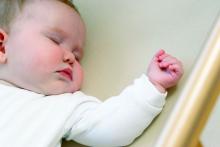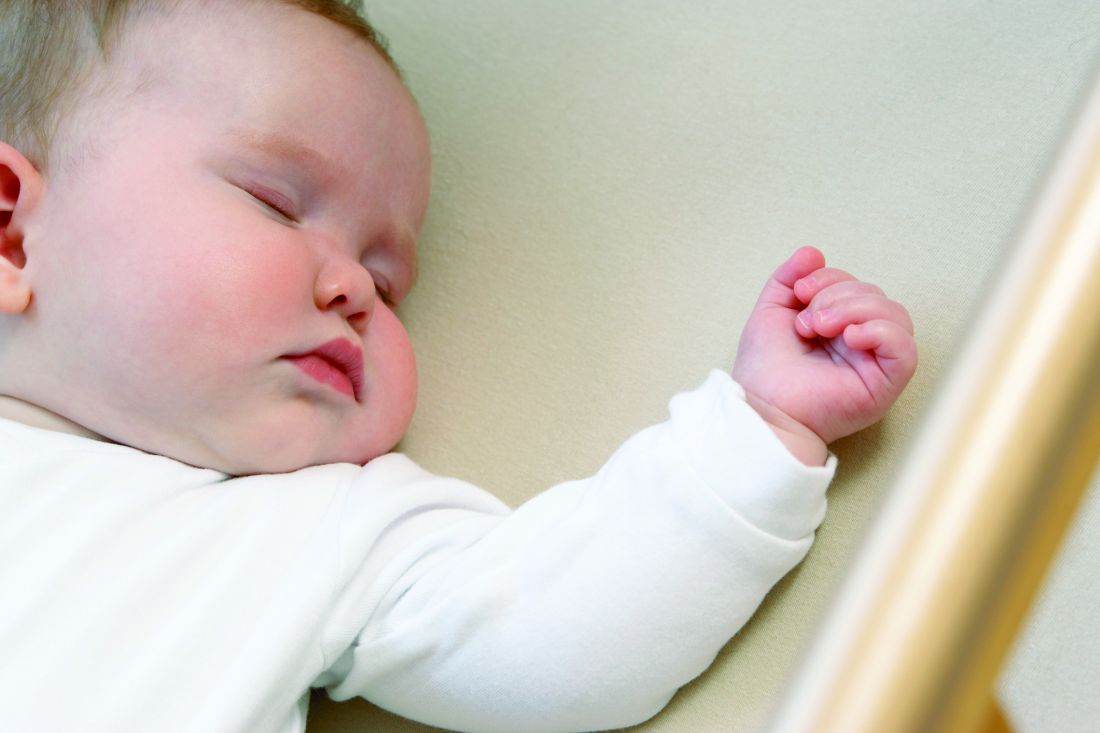User login
Sleep-related deaths among infants in the United States decreased during the 1990s as a result of recommendations to place babies on their backs to sleep. However, the decline has leveled off in recent years, and health care providers should proactively counsel caregivers about safe sleep practices, wrote Jennifer M. Bombard, MSPH, of the Centers for Disease Control and Prevention and her colleagues in a study published online in the Morbidity and Mortality Weekly Report.
Overall, 22% of respondents from 32 states and New York City in 2015 reported placing babies in a position other than their backs to sleep. In addition, 61% of respondents from 14 states reported bed sharing, and 39% from 13 states and New York City reported using soft bedding, including bumper pads and thick blankets.
Unsafe sleep practices varied by maternal demographics; nonsupine sleep positioning was more likely among non-Hispanic blacks, individuals aged 25 years or younger, those with 12 years or less of education, and those participating in the Special Supplemental Nutrition Program for Women, Infants, and Children.
“These findings highlight the need to implement and evaluate interventions to continue improving safe sleep practices,” Ms. Bombard and her associates said.
They cited the Study of Attitudes and Factors Effecting Infant Care Practices, in which caregivers who received appropriate advice on safe sleep practices were significantly less likely to place infants in a nonsupine position to sleep. “Evidence-based approaches to increase use of safe sleep practices include developing health messages and educational tools for caregivers and educating health and child care professionals on safe sleep practices,” they noted.
The study was limited by several factors, including reliance on self reports and inclusion of only states with Pregnancy Risk Assessment Monitoring System records, the researchers said.
Ms. Bombard and her associates had no relevant financial disclosures.
SOURCE: Bombard J et al. MMWR. 2018 Jan 9. doi: 10.15585/mmwr.mm6701e1.
Sleep-related deaths among infants in the United States decreased during the 1990s as a result of recommendations to place babies on their backs to sleep. However, the decline has leveled off in recent years, and health care providers should proactively counsel caregivers about safe sleep practices, wrote Jennifer M. Bombard, MSPH, of the Centers for Disease Control and Prevention and her colleagues in a study published online in the Morbidity and Mortality Weekly Report.
Overall, 22% of respondents from 32 states and New York City in 2015 reported placing babies in a position other than their backs to sleep. In addition, 61% of respondents from 14 states reported bed sharing, and 39% from 13 states and New York City reported using soft bedding, including bumper pads and thick blankets.
Unsafe sleep practices varied by maternal demographics; nonsupine sleep positioning was more likely among non-Hispanic blacks, individuals aged 25 years or younger, those with 12 years or less of education, and those participating in the Special Supplemental Nutrition Program for Women, Infants, and Children.
“These findings highlight the need to implement and evaluate interventions to continue improving safe sleep practices,” Ms. Bombard and her associates said.
They cited the Study of Attitudes and Factors Effecting Infant Care Practices, in which caregivers who received appropriate advice on safe sleep practices were significantly less likely to place infants in a nonsupine position to sleep. “Evidence-based approaches to increase use of safe sleep practices include developing health messages and educational tools for caregivers and educating health and child care professionals on safe sleep practices,” they noted.
The study was limited by several factors, including reliance on self reports and inclusion of only states with Pregnancy Risk Assessment Monitoring System records, the researchers said.
Ms. Bombard and her associates had no relevant financial disclosures.
SOURCE: Bombard J et al. MMWR. 2018 Jan 9. doi: 10.15585/mmwr.mm6701e1.
Sleep-related deaths among infants in the United States decreased during the 1990s as a result of recommendations to place babies on their backs to sleep. However, the decline has leveled off in recent years, and health care providers should proactively counsel caregivers about safe sleep practices, wrote Jennifer M. Bombard, MSPH, of the Centers for Disease Control and Prevention and her colleagues in a study published online in the Morbidity and Mortality Weekly Report.
Overall, 22% of respondents from 32 states and New York City in 2015 reported placing babies in a position other than their backs to sleep. In addition, 61% of respondents from 14 states reported bed sharing, and 39% from 13 states and New York City reported using soft bedding, including bumper pads and thick blankets.
Unsafe sleep practices varied by maternal demographics; nonsupine sleep positioning was more likely among non-Hispanic blacks, individuals aged 25 years or younger, those with 12 years or less of education, and those participating in the Special Supplemental Nutrition Program for Women, Infants, and Children.
“These findings highlight the need to implement and evaluate interventions to continue improving safe sleep practices,” Ms. Bombard and her associates said.
They cited the Study of Attitudes and Factors Effecting Infant Care Practices, in which caregivers who received appropriate advice on safe sleep practices were significantly less likely to place infants in a nonsupine position to sleep. “Evidence-based approaches to increase use of safe sleep practices include developing health messages and educational tools for caregivers and educating health and child care professionals on safe sleep practices,” they noted.
The study was limited by several factors, including reliance on self reports and inclusion of only states with Pregnancy Risk Assessment Monitoring System records, the researchers said.
Ms. Bombard and her associates had no relevant financial disclosures.
SOURCE: Bombard J et al. MMWR. 2018 Jan 9. doi: 10.15585/mmwr.mm6701e1.
FROM MMWR
Key clinical point: Health care providers can improve safe sleep for babies by counseling caregivers.
Major finding: Of respondents from 32 states and New York City in 2015, 22% reported placing babies in a position other than their backs to sleep.
Study details: The data come from the 2009-2015 Pregnancy Risk Assessment Monitoring System.
Disclosures: The researchers had no relevant financial disclosures.
Source: Bombard J et al. MMWR 2018 Jan 9. doi: 10.15585/mmwr.mm6701e1.

